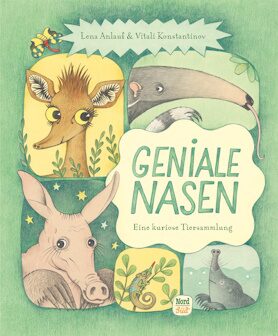Lena AnlaufVitali Konstantinov
Geniale Nasen. Eine kuriose Tiersammlung
[Amazing snouts. A curious collection of animals]
- NordSüd Verlag
- Zurich 2023
- ISBN 978-3-314-10633-0
- 64 Pages
- Publisher’s contact details
For this title we provide support for translation into the Italian language (2022 - 2024).
Sample translations
Animal Noses (and Snouts, and Trunks, and Beaks, and Proboscises . . .)
The title of this original picture book sparks readers’ curiosity, not least because the author-illustrator duo behind it have already shown themselves to be specialists in matters of the face with their book Bartgeschichten (“Beard Stories”), a short cultural history of facial hair—which of course is more than just a natural feature; it can also make a statement or signal religious identity.
Genius Noses is a miniature panopticon of curious animal noses—“nose” being a general term here. Organized by habitat—air and water, above ground and underground—the picture book presents about forty animals in all, from all over the world. There are well-known owners of large noses, like elephants and pigs, anteaters and tapirs, plus many animals unknown here in Europe. The names alone show us we’re in for something special, and some of them are a real mouthful: like the star-nosed mole, the black and rufous elephant shrew, the solenodon, or the Indonesian hog-nosed shrew rat. The fact that these animals all have Latin names as well makes translation easier, and boosts the book’s international viability.
Naturally the descriptions of each animal are centered around their often quite remarkable noses—their appearance and size, their form and function. But the olfactory organs are just the starting point for vivid portraits of the animals, with information about their habitats and habits, the food they eat, the skills they possess, and their role in the ecosystem. We learn astonishing facts, even about animals we think we know. For example, we learn that the elephant uses its trunk not only for eating, drinking, performing tasks, and of course smelling, but also for communication and showing affection. And we also learn that the folds of a bat’s nose are used to direct the ultrasonic sound waves used in echo-location.
But what would a picture book about noses be without the illustrations that go with it? Vitali Konstantinov’s drawings turn this motley nasal crew into a charming and quite captivating portrait gallery. Offering a mix of portraits, vignettes, and panoramas of various sizes in bright greens and yellows, the illustrations have a cheery, cheeky character, owing above all to the slightly skewed depictions of the animals. The artist is less concerned with precision and authenticity than with achieving a fresh, lively look. This means cartoon-like animal faces with giant eyes and human-like expressions, scenes that visualize the actions of smelling and touch, and comic gestures and poses.
Solid and astounding information and quirky images combine to make an educational picture book for children whose entertainment factor couldn’t be any higher. As far as the selection of animals goes, one might ask why only four species of bird, three of fish, and so few insects are included. That fish can’t smell very well, and insects not at all, isn’t the most convincing of reasons. This reviewer for one would have liked to learn even more about the Gambian pouched rat, which can help detect illnesses and even discover buried landmines with its keen nose. What an amazing talent! Couldn’t humanity make even greater use of it?
The ample back matter shows that, for all its quirkiness and its focus on far-out details, the picture book rests on a strong scientific basis. An extensive glossary, notes, and a comprehensive index round out the volume. The front endpapers also feature a world map which shows that only a few of the animals presented live in Europe—the book is truly international in scope. The back endpapers, meanwhile, have a size chart that makes it clear how big these curious noses—and the animals they belong to—are compared to humans. What more could you ask for?
Translated by Marshall Yarbrough

By Sylvia Schwab
Sylvia Schwab is a radio journalist with a special interest in literature for children and teenagers. She serves on the jury for the monthly ‘Best 7’ list of books for young readers produced under the aegis of Deutschlandfunk and Focus, and works for Hessischer Rundfunk, Deutschlandfunk and Deutschlandradio-Kultur.
Publisher's Summary
This collection of animals of a special kind carries us across the entire globe and fills us with wonder at the fascinating multiplicity of nature. Russian desmans, elephants, pigs and saiga antelopes: all of them have extraordinary snouts. Snouts tell us a great deal about the habits and habitats of animals.
(Text: NordSüd Verlag)
